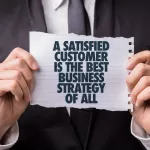A Leader’s Perspective on Business Transformation
Even with the best intentions and a well thought out plan, a leader can be caught off guard by the size and types of changes that come with improvement efforts. While they are not always predictable, it is his/her responsibility to be prepared, create an environment receptive to these changes, and work within the context of his/her organization’s larger business strategy. What makes it more complicated is change management often involves improving several parts of the business to have the desired effect.
Change Management Requires Collaboration
One mistake leaders make is to try and justify changes within active policies and processes. What often happens after improvements are made is the culture will “backslide” to the original way of doing things. A better approach is to first review your vision, purpose, and policies. Not just the formal policies but the informal ones that your culture has adopted to make sense of unclear expectations. Next, develop a compelling rationale for change based upon the guidance within vision and mission statements. This will get employees more engaged, even inspire them, and likely bring more of them on board sooner.
Change management as a leader, whether under the banner of Lean, Six Sigma, Business Process Re-engineering, etc., demands an appreciation for the needed changes and the time required to prepare for them. Knowing where the company is going ahead of time helps. A word on Improving your chances of success.
Change in Policies
- Human Relations (HR) – The organization must now strive to be a “learning organization.” This means that everyone must be thoroughly trained and certified, ready to engage in individual and team problem solving, and capable of seeing new opportunities for change
- Accounting-Finance – The meaning of “value” will change, and so require a different set of metrics to reflect that change
- Supply Chain – Relationships will likely change as the organization begins to place greater demands on its vendors in such areas as quantity, frequency of delivery and packaging
- Customer service – There is an increased focus on the needs of the customer, resulting in changes in the number and quality of communication
- Operations – Changes may occur in how equipment is arranged, operated and maintained to re-balance capacity as a buffer or use extra shifts
Change in Organizational Structure
There are 12 aspects to organizational structure and strategy. In most cases all 12 won’t need revising but changes to more than one is always required. The goal isn’t to transform your company all at once but to maximize the effectiveness and improve long-term success of your efforts. If you find while doing process improvements that your vision, mission or policies don’t quite fit, then it’s probably a good time to revisit your strategy.
You may need to make changes to your organizational structure.
These are some of the questions you will want to keep in mind:
- Will you need to modify the company’s configuration?
- Should you consider a matrix organization to maximize expertise?
- Will you need to increase / decrease the organization’s complexity?
- A complex company can hinder quick decisions, if all decisions are made by the boss
- Will you need more formal processes to support the changes?
- If employees freely change or create processes, formalizing processes is the best way to anchor improvements for consistency
- How will you change the coordination and control of activities?
- In addition to incentives, centralization, and formalization, how do the functional departments need to work together?
- Where will you make decisions?
- Will decision making be closer to where the value is created?
- Some areas may need the decisions more centralized while others may need to be decentralized.
- How will you modify the incentive program?
- What is the right balance between process and results incentives?
- What is the right balance between individual and team based incentives?
As you consider structural changes, your policies and processes should support and align with the changes. Many times, policies will describe how functional departments should work together. If there are misfits between departments, there will be conflicts among policies. So, processes are what your employees will mainly be focusing on, so it’s important they have good policies to follow. Also, make sure your employees have the best environment to work within.
Be Prepared by Starting With Policies
Prepare to achieve your initiatives by considering your policies and company structure in advance. The goal is to create an environment that will facilitate and support intended results. Your effectiveness depends upon knowing how you can provide the right support to your employees. Their participation in activities is very important, and if you ask them to change within the context of existing control, you could very well be stifling their involvement and creativity. Worse, you could be setting them up to fail.







